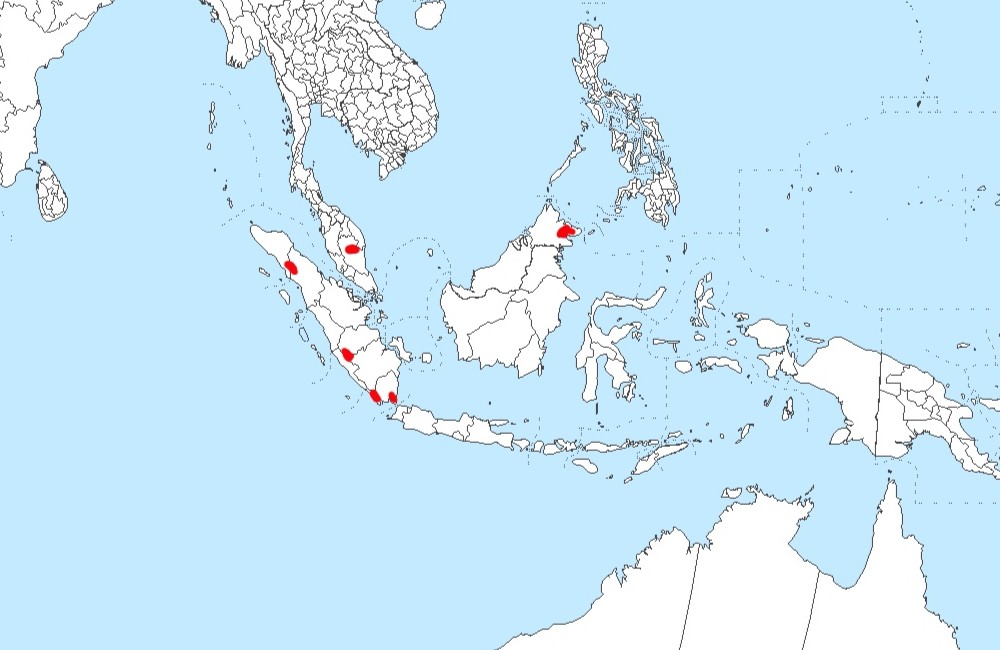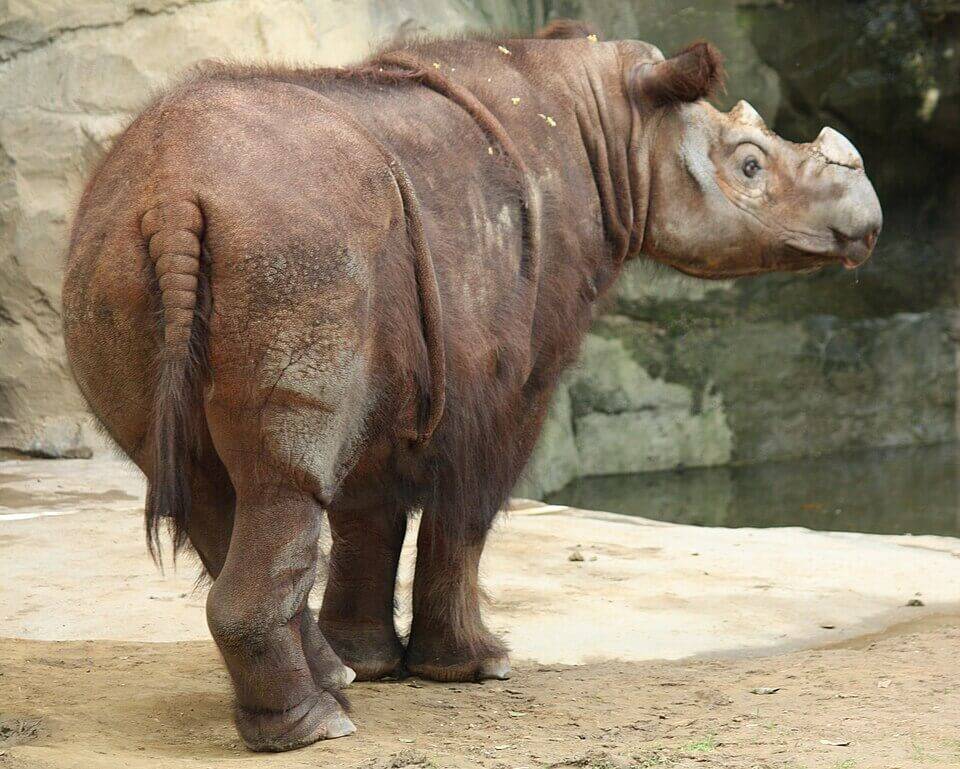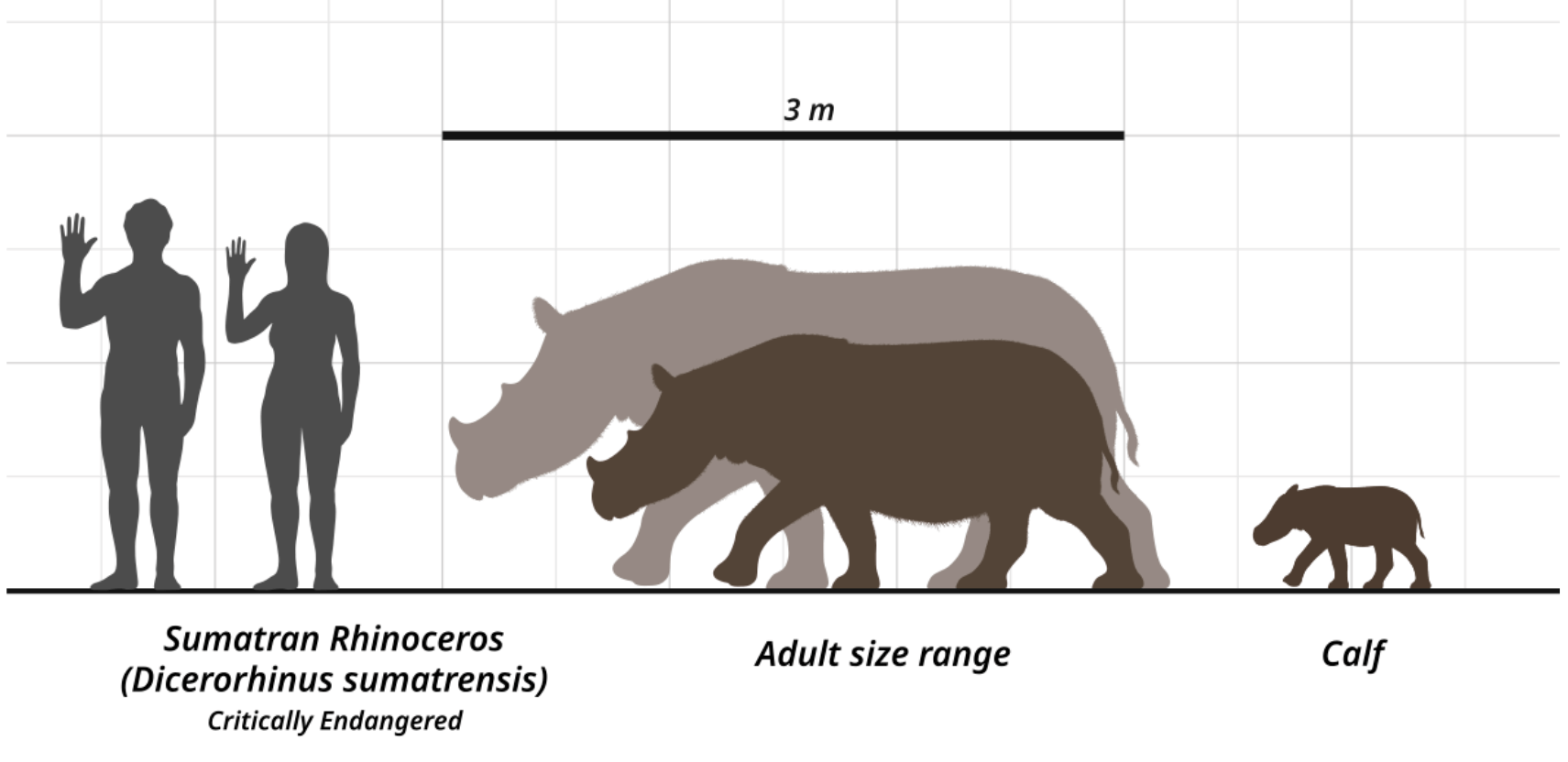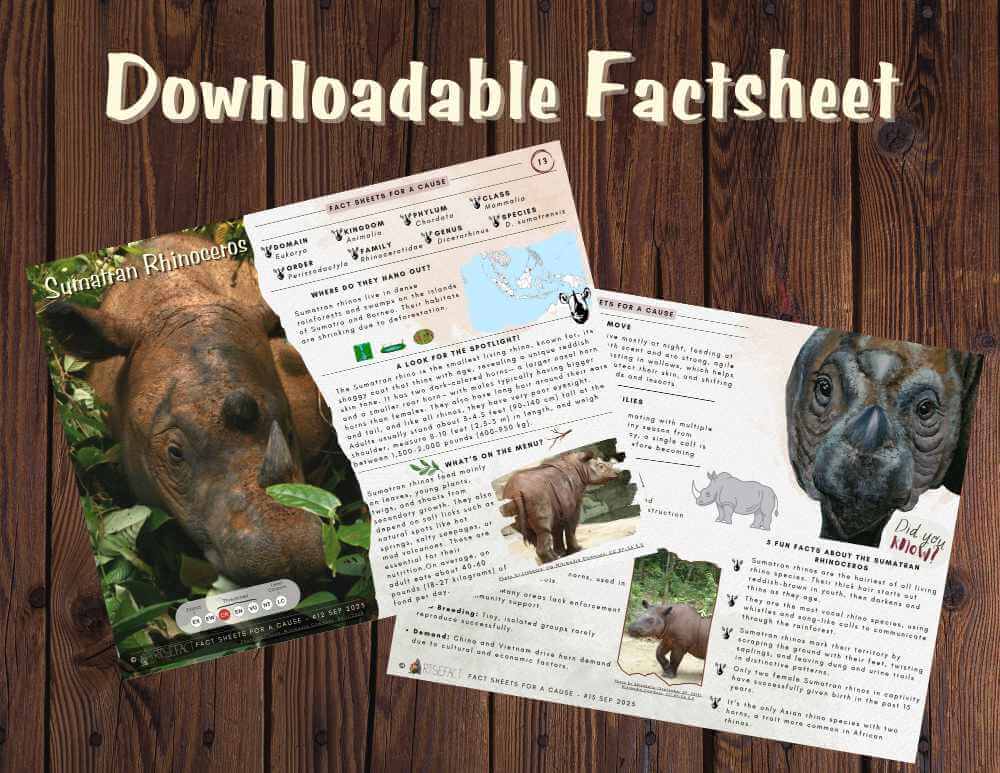
Meet the Sumatran Rhinoceros
The Sumatran rhino is the smallest and hairiest rhino species, found in the forests of Sumatra and Borneo. Known for its two horns and reddish-brown coat, it plays a key role in forest health but faces severe threats from habitat loss and poaching. Fewer than 80 remain, making it a critically endangered species. But is it the rarest of them all? Not quite. The Javan Rhino edges it out in rarity, yet the Northern White Rhino takes the crown, with only two females left on Earth.
Scientific Name: Dicerorhinus Sumatrensis
Phylum: Chordata
Order: Perissodactyla
Genus: Dicerorhinus
Kingdom: Animalia
Class: Mammalia
Family: Rhinocerotidae
Species: D. sumatrensis
IUCN Redlist Status:
The Sumatran Rhinoceros is listed as Critically Endangered on the IUCN Red List of Threatened Species. This means it faces an extreme risk of extinction in the wild, with fewer than 80 individuals estimated to remain in the wild.

Life in the Rainforest

Unlike their grassland cousins, Sumatran rhinos live in dense rainforests and swamps on the islands of Sumatra and Borneo. They navigate thick vegetation like stealthy giants, munching on more than 100 species of plants: leaves, twigs, bark, and fruit. Their home turf is mountainous, humid, and often muddy, and they love a good wallow to cool down and keep away parasites. These shy and solitary creatures are mostly active during the early morning and late afternoon, using their keen sense of smell to find food and detect danger. Despite their large size, they are surprisingly agile, able to move silently through tangled undergrowth. The rainforest provides not just sustenance, but also shelter, hiding spots, and natural trails that the rhinos use to travel between feeding grounds, waterholes, and mud pools.
What’s on the Menu?

Sumatran rhinos are true forest foodies, spending much of their day munching on an impressive buffet of plants. Their diet includes leaves, twigs, bark, and fruit, and they can eat more than 50 pounds of vegetation every day! By browsing on so many different plants, they actually help shape the rainforest around them, keeping it healthy and diverse. Sometimes, they even knock down small trees to reach leaves, proving that mealtime is also a bit of gardening. They have a particular fondness for fruit, which provides extra energy, and their strong lips make plucking leaves and stripping bark almost effortless. Occasionally, they will nibble on mineral-rich soil or clay to supplement nutrients, showing just how resourceful they are when it comes to staying nourished in their lush but challenging home.
The Singing Rhinoceros

Unlike most of their rhino cousins, Sumatran rhinos are surprisingly chatty. They’re known for their high-pitched calls, squeaks, and whistles, earning them the nickname “the singing rhino.” Some of their calls travel long distances through the dense rainforest, helping them find one another in the wild. Scientists even compare their sounds to those of whales, except that instead of echoing through the ocean, these songs bounce through the jungle. They use different calls for different occasions, some to signal alarm, others to attract mates, and even gentle grunts when relaxing in mud pools. Each rhino has its own unique “voice,” which researchers can sometimes identify, making it feel like the rainforest has its own secret symphony. It’s one of the many quirks that make this species so fascinating and unique.
Sumatran Rhinoceros Fun Facts
- Salt Spa Lovers – Sumatran rhinos visit natural salt licks to get vital minerals and to pick up scents from other rhinos. Sadly, poachers often set traps along these trails.
- Mud Bath Addicts – They spend hours wallowing in mud holes to stay cool, keep their skin healthy, and get rid of pesky insects. Some wallows are used for years, becoming giant dug-out pools in the forest.
- Built-in Weapons – Unlike African rhinos, Sumatran rhinos have sharp lower incisor teeth they use in fights, which can cause serious wounds.
- Forest Ninjas – Despite their bulk, they’re fast, agile, and can climb steep mountains or riverbanks with ease.
- Super Chewers – Their teeth are designed to cut woody plants into neat little 1–2 cm chunks, but as they age, their teeth wear down, sometimes leading to starvation.
- The Smallest Rhino on Earth – The Sumatran rhino holds the title of being the smallest of all living rhinoceros species
- Long Pregnancy: They have one of the longest gestation periods among mammals: around 15–16 months! Calves are born surprisingly tiny compared to their mothers, often weighing less than 100 pounds at birth, and rely on their mom for the first few years.

Threats to their survival
One of the biggest threats to the survival of the Sumatran rhinoceros is the rapid loss of its natural habitat. These rhinos depend on dense tropical rainforests, but vast areas of their home in Sumatra and Borneo have been cleared for agriculture, logging, and especially palm oil plantations. As forests shrink, rhinos are pushed into smaller and more isolated patches of land, which makes it harder for them to find food, mates, and safe territory. This fragmentation not only reduces their population size but also traps them in small groups, leading to inbreeding and lower genetic diversity, further putting the species at risk.
Conservation Efforts & How You Can Help

Saving the Sumatran rhino is a race against time, but dedicated conservationists are working tirelessly to protect the species. In Indonesia, the Sumatran Rhino Sanctuary in Way Kambas National Park provides a safe haven where rhinos are cared for and part of an international breeding program. This program has already celebrated several rare rhino births in captivity, an enormous milestone for such a critically endangered species. In the wild, efforts focus on anti-poaching patrols, habitat protection, and connecting fragmented forests so isolated rhinos have a chance to find each other and breed.
You don’t have to be a scientist to make a difference. Everyday choices can help too. Supporting organizations like the International Rhino Foundation or WWF ensures funds go directly to rhino protection and community programs. Choosing products made with sustainable palm oil helps reduce rainforest destruction, while simply spreading awareness about the Sumatran rhino brings more attention to their plight. Every voice counts, and with global support, this “singing rhino” still has a chance to thrive.
Lastly, Shop at Artsefact: Part of the proceeds go towards wildlife and habitat conservation.
Buy Art & Save Wildlife
10% of all profits support wildlife and habitat conservation efforts, so every artwork you collect helps protect the planet.
Sumatran Rhinoceros Factsheet
Would you like a Sumatran Rhinoceros fact sheet?
- Sign up for our newsletter for exclusive updates and wildlife conservation tips (Your welcome email has your Password for the Portal)
- Visit https://artsefact.com/factsheets/ where you can access and download ALL Factsheets & Gain Early Access to NEW Factsheets

Here’s how you can gain access:
Resources
- World Wildlife Fund – https://www.worldwildlife.org/species/sumatran-rhino
- Save the Rhino International – https://www.savetherhino.org/rhino-info/rhino-species/sumatran-rhino/




